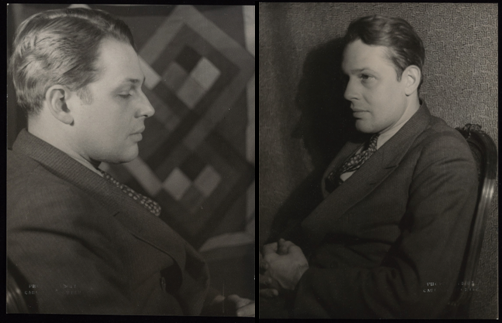
Researching the lives of ancestors or local figures can lead you to treasures you never suspected existed. My research into the life of playwright Robert Turney led me to find these photographs by the famous Photographer Carl Van Vechten. (Photographs by Carl Van Vechten, December 29, 1935. Published here with permission from the Van Vechten Trust).
Have you ever wanted to research your family history or to look into the lives of a prominent local figure from the past? Chances are the task seemed quite daunting at first. Where do you look to find key information about their everyday life? I was in the same position when I began my internship at the Oakville Museum, but through practice I have been able to gain experience and achieve success at tracking down sources to build historical biographies. In order to help you with your own investigations, here are five helpful tips to remember when you’re researching people from the past.
1. Starting with a specialized database like Ancestry.com can be a great help.
If you are looking for a good starting point to find basic information on an ancestor or historical figure, a database like Ancestry.com or FamilySearch.org can be a great place to start. These databases have access to censuses, birth certificates, marriage records and other assorted documents that can be key to finding out basic information. With this information, finding birth dates, places of residence and other facts should be made much simpler. While Ancestry.com requires subscription, many libraries (including the University of Toronto) have the library version free of charge.
2. Newspaper databases contain a wealth of information.
Once you have some basic information, it is time to start a more in-depth search, and newspaper databases can be very helpful for this. If you are researching someone who lived in New York in the 1880s, for example, a search through the New York Times’ online database may be able to find some mention of your target person giving you a glimpse into their daily actions. Obituaries and birth and marriage notices are also very helpful. By looking through a database of Halton newspapers I was able to find that Allan Chisholm, a person I was researching, died in Philadelphia, which then led me to search through Philadelphia newspapers for further information. Some newspapers offer free archives and others are available through libraries and universities.
3. Build upon what you have found in order to narrow your searches.
I found out that Allan Chisholm lived in Buffalo in the 1880s and 90s. From that point, I was able to target my searches for information to records around Buffalo which vastly increased my chances of success. I was able to find directories listing where he lived and worked and some records from his coal business. Focusing your searches to specific areas, times, industries or hobbies that you have found your person to be active in will make your task much easier and help you find the most relevant sources.
4. For images, try databases at libraries and archives.
In many cases finding images of people you are searching for can be difficult, if not impossible. That is no reason not to try, however, and libraries and archives often contain great stores of images that can be useful to a researcher. The images on the top of this post were taken by the famous photographer Carl Van Vechten in 1935 of Robert Turney, an actor and playwright from New York, and are published here with permission of the Van Vechten Trust. You don’t just have to look for images of people, try searching for a business, society, or club that the person you are researching was involved in. For example, I have been able to find images of a lumber company that a man I am researching was involved in, even if I have yet to find an image of the man himself. Make sure to ask permission to use a photograph from the library or archive in question and to follow the conditions for use they set out.
5. Every piece of information you find can provide you with new leads.
Every piece of information you find is a victory that can lead you to many new sources of information. For example, when I found Allan Chisholm worked for a company named Chisholm and Parrish, a search for the company brought me to not only business documents but a yacht owned by the company. This revealed that Allan was heavily involved in the Buffalo Yacht Club (Vice-Commodore in 1888) and in the Oakville Yacht Club as well. I would have had no idea to search the Buffalo Yacht Club records had I not followed a trail of sources that led me there, after starting with only a small amount of information around his actions at a house in Oakville. Finding information can be challenging, but when a new lead brings you to a wealth of information you never even knew existed it can feel immensely rewarding. So if you have an interest in the past of your family or of prominent figures in your community, get researching and you never know what you might be able to find.
